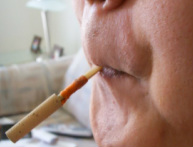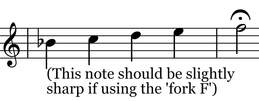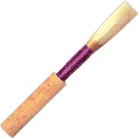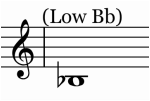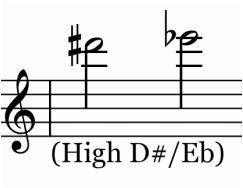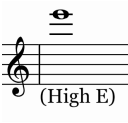DISCLAIMER: The quality of equipment (instrument, reed) has a very big impact on intonation. If the equipment is not in working order, the information and techniques on this webpage will not be as effective.
Embouchure Check!Your embouchure formation can either help or hurt your pitch accuracy. Here is a brief reminder about how you should form your embouchure:
|
The CrowNext, let's make sure that your reed is in good working order. The reed is another factor that effects intonation immensely.
A well balanced reed will make a good 'crow' sound. The crow is a multi-pitched sound. For the oboe, a stable octave 'C' crow sound is most desirable. Listen to the example on the right and imitate the sound that you hear. |
How To Tune The Oboe
Once you have reviewed and practiced your embouchure formation and crow production, check your oboe intonation using the procedure listed below:
1) Play for a few minutes to warm up your embouchure muscles and the instrument. Be sure that the reed is pushed all the way down into the receptor (always start with it there).
4) Check the 2nd space 'A' and 'A' above the staff. The note 'A' is the most centered on the instrument.
Ways to Adjust Pitch on the Oboe
Even after tuning our instrument, there will still be notes that are naturally out-of-tune for various reasons. This makes it necessary for us to adjust, or manipulate, the pitch while playing. Here are some simple ways to adjust pitch:
Amount of Reed in Mouth
Embouchure Tension
|
Air Stream Direction and Vowels
Alternate/Resonance FingeringsFor many notes that tend to be sharp, you can add resonance fingerings to bring the pitch down. A few examples are listed below in the "alternate fingerings" section.
|
Other Factors Effecting Pitch
Reeds
Posture/Breath Support
|
Pads and Keys
Temperature
|
Pitch Tendencies
Every instrument has notes that are naturally out of tune. Here is a list of common naturally out-of-tune notes for the oboe:
Common Alternate Fingerings to Help With Intonation
For many of the naturally out-of-tune notes, the most effective way to adjust pitch is to change the amount of reed in your mouth and the amount of tension in your embouchure. Review the information higher up on this page for more details regarding this. Here is a list of commonly used alternate fingerings for a few of the notes listed above:
Oboe Videos
|
|
|
